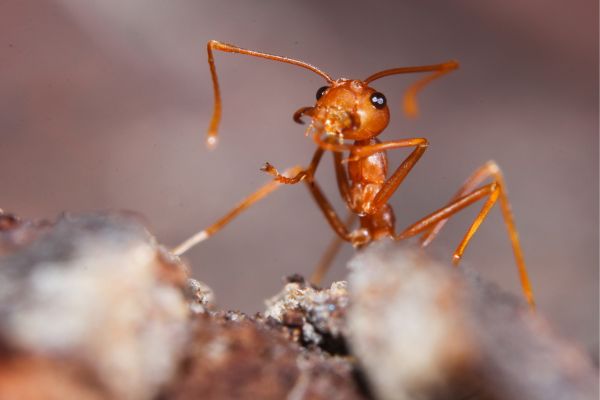Your cart is currently empty!

07 Jul How To Identify Fire Ants: Characteristics And Appearance
Fire ants, with their aggressive behaviour and painful stings, are a common nuisance in many parts of the world. Being able to identify these ants is essential for effective pest management and to minimize the risk of painful encounters. In this article, we will explore the characteristics and appearance of fire ants, equipping you with the knowledge to identify them and take appropriate action.
Fire ants belong to the genus Solenopsis and encompass various species, with the red imported fire ant (Solenopsis invicta) being the most well-known and widespread. These ants have a distinctive appearance that sets them apart from other ant species.
Here are some key characteristics to look out for when identifying fire ants:
1. Size:
Fire ants are relatively small insects, typically measuring between 1/8 to 1/4 inch in length (2-6 mm). The workers, which are the ones you are most likely to encounter, are similar in size to common household ants.
2. Colour:
Fire ants exhibit a reddish-brown to reddish-black colouration, which can vary slightly depending on the species and the individual ant. The reddish hue is particularly prominent on their heads and bodies.
3. Body Structure:
Fire ants have a distinct body structure comprising three main sections: the head, thorax, and abdomen. The head is relatively large, featuring chewing mouthparts, compound eyes, and long, elbowed antennae. The thorax connects the head and abdomen and contains six legs. The abdomen is oval-shaped and attached to the thorax via a slender waist, giving fire ants a characteristic segmented appearance.
4. The “Sting” In Fire Ants:
Unlike most ants, fire ants possess a venomous sting. The stinger is located at the rear end of their bodies. While it may not be visible to the naked eye, it plays a significant role in their aggressive defence mechanism and inflicting painful stings on intruders.
Identifying fire ant colonies can be equally important in managing their presence.
Fire ants build extensive underground nests with distinctive features that can aid in their recognition:
1. Mounds:
Fire ant colonies construct mounds of soil that are often irregular in shape and range in size. These mounds can reach heights of several inches and have no visible entry or exit holes on the top. It’s important to note that not all fire ant colonies build mounds, particularly in areas with loose soil or frequent disturbances.
2. Satellite Nests:
Fire ants establish multiple satellite nests surrounding the main colony. These smaller nests are usually located in nearby areas such as lawns, gardens, or cracks in pavements. Satellite nests can provide valuable clues when trying to locate and identify fire ant colonies.
Now that you are equipped with the knowledge to identify fire ants, it’s time to take action and protect yourself and your surroundings from these troublesome insects. Introducing Nemaknights Ant Attack: An Effective and Environmentally Friendly Solution. It is a powerful product designed to repel and eliminate fire ants without causing harm to the environment.
Nemaknights Ant Attack is formulated using eco-friendly ingredients that effectively disrupt fire ant colonies and deter their presence. By targeting the ants’ instincts, it creates an inhospitable environment for fire ants, prompting them to seek alternative habitats away from your home, garden, or recreational areas. Visit the Environmental Factor website to purchase it today!


